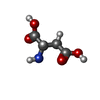[English] 日本語
 Yorodumi
Yorodumi- PDB-9bh0: Ancestral uncoupled aspartate transporter in complex with L-aspartate -
+ Open data
Open data
- Basic information
Basic information
| Entry | Database: PDB / ID: 9bh0 | |||||||||
|---|---|---|---|---|---|---|---|---|---|---|
| Title | Ancestral uncoupled aspartate transporter in complex with L-aspartate | |||||||||
 Components Components | Aspartate transporter | |||||||||
 Keywords Keywords | TRANSPORT PROTEIN / Transporter / ion-uncoupled / ancestral | |||||||||
| Function / homology | ASPARTIC ACID Function and homology information Function and homology information | |||||||||
| Biological species | synthetic construct (others) | |||||||||
| Method | ELECTRON MICROSCOPY / single particle reconstruction / cryo EM / Resolution: 3.4 Å | |||||||||
 Authors Authors | Reddy, K.D. / Boudker, O. | |||||||||
| Funding support |  United States, 2items United States, 2items
| |||||||||
 Citation Citation |  Journal: bioRxiv / Year: 2024 Journal: bioRxiv / Year: 2024Title: Evolutionary analysis reveals the origin of sodium coupling in glutamate transporters. Authors: Krishna D Reddy / Burha Rasool / Farideh Badichi Akher / Nemanja Kutlešić / Swati Pant / Olga Boudker /  Abstract: Secondary active membrane transporters harness the energy of ion gradients to concentrate their substrates. Homologous transporters evolved to couple transport to different ions in response to ...Secondary active membrane transporters harness the energy of ion gradients to concentrate their substrates. Homologous transporters evolved to couple transport to different ions in response to changing environments and needs. The bases of such diversification, and thus principles of ion coupling, are unexplored. Employing phylogenetics and ancestral protein reconstruction, we investigated sodium-coupled transport in prokaryotic glutamate transporters, a mechanism ubiquitous across life domains and critical to neurotransmitter recycling in humans. We found that the evolutionary transition from sodium-dependent to independent substrate binding to the transporter preceded changes in the coupling mechanism. Structural and functional experiments suggest that the transition entailed allosteric mutations, making sodium binding dispensable without affecting ion-binding sites. Allosteric tuning of transporters' energy landscapes might be a widespread route of their functional diversification. | |||||||||
| History |
|
- Structure visualization
Structure visualization
| Structure viewer | Molecule:  Molmil Molmil Jmol/JSmol Jmol/JSmol |
|---|
- Downloads & links
Downloads & links
- Download
Download
| PDBx/mmCIF format |  9bh0.cif.gz 9bh0.cif.gz | 82.4 KB | Display |  PDBx/mmCIF format PDBx/mmCIF format |
|---|---|---|---|---|
| PDB format |  pdb9bh0.ent.gz pdb9bh0.ent.gz | 61.6 KB | Display |  PDB format PDB format |
| PDBx/mmJSON format |  9bh0.json.gz 9bh0.json.gz | Tree view |  PDBx/mmJSON format PDBx/mmJSON format | |
| Others |  Other downloads Other downloads |
-Validation report
| Summary document |  9bh0_validation.pdf.gz 9bh0_validation.pdf.gz | 1.3 MB | Display |  wwPDB validaton report wwPDB validaton report |
|---|---|---|---|---|
| Full document |  9bh0_full_validation.pdf.gz 9bh0_full_validation.pdf.gz | 1.3 MB | Display | |
| Data in XML |  9bh0_validation.xml.gz 9bh0_validation.xml.gz | 25.7 KB | Display | |
| Data in CIF |  9bh0_validation.cif.gz 9bh0_validation.cif.gz | 34.2 KB | Display | |
| Arichive directory |  https://data.pdbj.org/pub/pdb/validation_reports/bh/9bh0 https://data.pdbj.org/pub/pdb/validation_reports/bh/9bh0 ftp://data.pdbj.org/pub/pdb/validation_reports/bh/9bh0 ftp://data.pdbj.org/pub/pdb/validation_reports/bh/9bh0 | HTTPS FTP |
-Related structure data
| Related structure data |  44528MC  9bgyC  9bgzC  9bh1C  9bh2C M: map data used to model this data C: citing same article ( |
|---|---|
| Similar structure data | Similarity search - Function & homology  F&H Search F&H Search |
- Links
Links
- Assembly
Assembly
| Deposited unit | 
|
|---|---|
| 1 |
|
- Components
Components
| #1: Protein | Mass: 43910.488 Da / Num. of mol.: 1 Source method: isolated from a genetically manipulated source Details: C-terminal thrombin cleavage site, Twin-Strep tag, ALFA tag, and (HIS)10 tag. Engineered with loops and tails from NCBI KJS87745.1 Source: (gene. exp.) synthetic construct (others) / Production host:  |
|---|---|
| #2: Chemical | ChemComp-ASP / |
| Has ligand of interest | Y |
| Has protein modification | N |
-Experimental details
-Experiment
| Experiment | Method: ELECTRON MICROSCOPY |
|---|---|
| EM experiment | Aggregation state: PARTICLE / 3D reconstruction method: single particle reconstruction |
- Sample preparation
Sample preparation
| Component | Name: Ancestral uncoupled aspartate transporter in complex with L-aspartate Type: COMPLEX / Entity ID: #1 / Source: RECOMBINANT |
|---|---|
| Source (natural) | Organism:   Pyrococcus horikoshii (archaea) Pyrococcus horikoshii (archaea) |
| Source (recombinant) | Organism:  |
| Buffer solution | pH: 7.4 / Details: 20 mM HEPES, 100 mM NMDG-Cl, 1 mM L-Asp |
| Specimen | Embedding applied: NO / Shadowing applied: NO / Staining applied: NO / Vitrification applied: YES |
| Vitrification | Cryogen name: ETHANE |
- Electron microscopy imaging
Electron microscopy imaging
| Experimental equipment |  Model: Titan Krios / Image courtesy: FEI Company |
|---|---|
| Microscopy | Model: FEI TITAN KRIOS |
| Electron gun | Electron source:  FIELD EMISSION GUN / Accelerating voltage: 300 kV / Illumination mode: FLOOD BEAM FIELD EMISSION GUN / Accelerating voltage: 300 kV / Illumination mode: FLOOD BEAM |
| Electron lens | Mode: BRIGHT FIELD / Nominal defocus max: 2100 nm / Nominal defocus min: 900 nm |
| Image recording | Electron dose: 58 e/Å2 / Film or detector model: GATAN K3 (6k x 4k) |
- Processing
Processing
| CTF correction | Type: PHASE FLIPPING AND AMPLITUDE CORRECTION |
|---|---|
| 3D reconstruction | Resolution: 3.4 Å / Resolution method: FSC 0.143 CUT-OFF / Num. of particles: 71731 / Symmetry type: POINT |
 Movie
Movie Controller
Controller






 PDBj
PDBj


